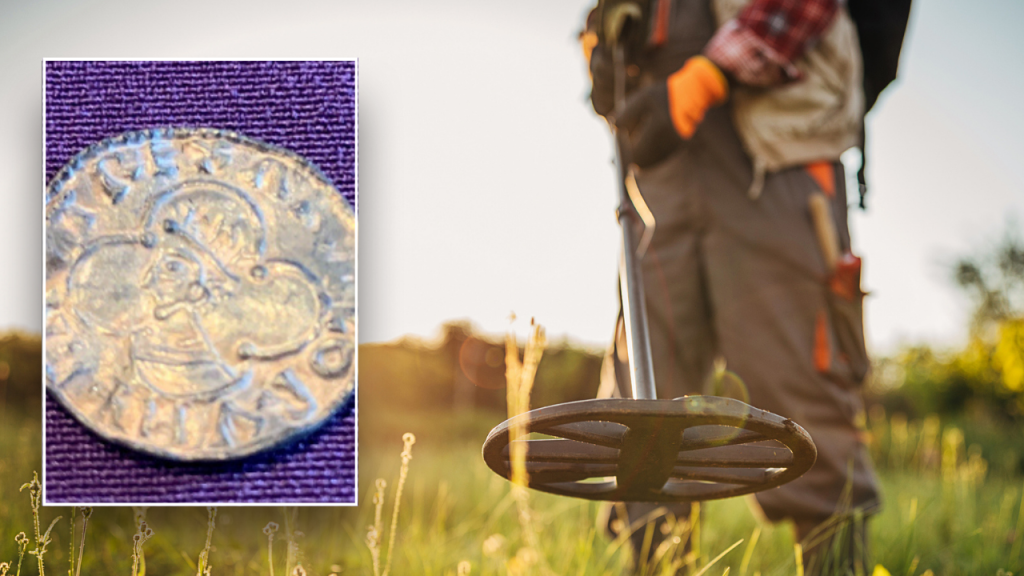British historians recently announced the discovery of a 1,000-year-old Viking “wallet” containing 36 silver coins minted between 1000 and 1065. The hoard was found by metal detectorists John Crowe and David O’Hare on private land on the Isle of Man in May. The coins were minted during the reign of Edward the Confessor, Aethelred II, and Canute, representing various English mints as well as Irish coins from Dublin featuring King Sihtric Silkbeard. Dr. Kristin Bornholdt Collins, a researcher, likened the discovery to a wallet due to the variety of currencies, providing a rare opportunity to study closely dated comparative material from separate finds.
Historians believe the hoard was abandoned around 1070 and sheds light on the trade history of the time. The geographical range of mints represented in the hoard illustrates a vibrant and mobile economy with traders and cash moving through Ireland and England, via the Isle of Man, during the Viking era. Allison Fox, a curator for Manx National Heritage, noted that the discovery provides valuable information about the history of the island, which is known to harbor priceless Viking artifacts. The discovery helps further understand the complex Viking Age economy in the Isle of Man, where more Viking Age silver has been discovered per square kilometre than in England, Ireland, Scotland, and Wales.
The Viking “wallet” discovery marks an important find in the field of archaeology, as it offers insight into the variety of currencies circulating during the Viking era. The treasure hoard contains coins minted by English kings and Norse rulers, reflecting the diverse economic activity in the region during that time. The close dating of the comparative material found in the hoard is highly unusual and provides researchers with an opportunity to delve into the details of the coin dies used to strike the currency. Dr. Kristin Bornholdt Collins emphasized the significance of this discovery in understanding the trading practices and economic interactions between different regions during the Viking Age.
The hoard of Viking coins found on the Isle of Man also sheds light on the historical context of the period, revealing the presence of Viking rulers and their influence in the region. Canute, also known as Cnut, was a Viking ruler who unified the kingdoms of England and Denmark, leaving a lasting impact on the political landscape of the time. The discovery of the hoard in 1070 suggests that it may have been abandoned during a period of significant change or upheaval, adding to the mystery and intrigue surrounding the artifacts. The treasure hoard provides a glimpse into the trading networks and economic activities that were prevalent in the Isle of Man during the Viking era, contributing to our understanding of the region’s history.
The discovery of the Viking “wallet” by metal detectorists John Crowe and David O’Hare highlights the importance of amateur archaeologists in uncovering valuable historical artifacts. Their find on private land in the Isle of Man showcases the potential for individuals with a passion for history and archaeology to contribute to our understanding of the past. The collaboration between these metal detectorists and academic researchers demonstrates the importance of partnerships in archaeological research and the significance of engaging with local communities to uncover hidden treasures. The discovery of the hoard opens up new avenues for research and exploration into the Viking presence on the Isle of Man and the economic activities that shaped the region during that time.
Overall, the discovery of the 1,000-year-old Viking “wallet” on the Isle of Man represents a significant contribution to the study of Viking history and trade networks in the region. The hoard of silver coins provides valuable insights into the economic activities and trading relationships that existed during the Viking era, highlighting the vibrant and mobile nature of commerce in the region. The variety of currencies found in the hoard, including coins minted by English kings and Irish rulers, offers a unique opportunity for researchers to delve into the nuances of the period and better understand the intricate interplay of different cultures and economic systems. The discovery serves as a reminder of the rich tapestry of history that exists beneath the surface and the potential for further discoveries to enhance our knowledge of the past.


